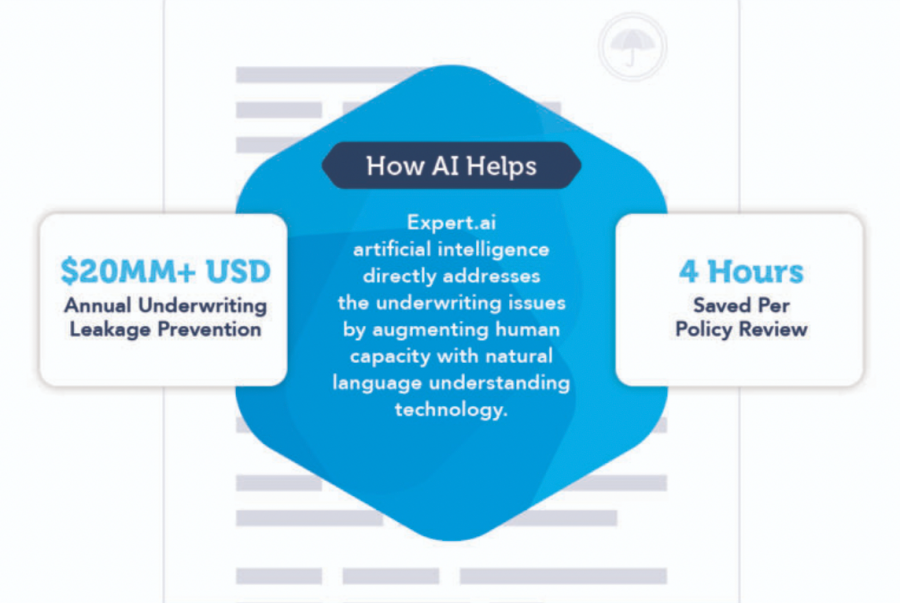
One of the biggest business impacts of Covid was the acceleration of digital transformation. This has been felt acutely in the insurance sector, which is undergoing many simultaneous shifts based on pressure on the combined ratio, competition, shifting customer expectations, added complexity, and the accessibility to specialized skills. To address these challenges, AI technologies are giving insurers the opportunity to transform some of their most complex processes and set the stage for competitive advantage.
But which technologies are providing value and where? The frenzy around large language models (LLMs) and ChatGPT has brought language-based AI into the popular consciousness, making it challenging for companies to sort through the hype and navigate fears of getting left behind, losing market share or running into governance and compliance issues.
In reality, we know that companies in many industries—especially the insurance sector—are already successfully embedding AI into their operations. Accenture found that 80% of claims executives say that automation, AI and machine learning-based data analytics can add value, and they plan to invest more than $10 million into AI in the next three years.
For several years now, we’ve been working with insurance companies around the world on some very established use cases where language-based AI and natural language processing (NLP) are helping insurers transform some of their most labor- and data-intensive processes into efficiency and insight machines. We’ll be pointing the spotlight on these AI powered use cases in this post
Current AI Trends in the Insurance Industry
But first, let’s look at the state of insurance in 2023 in order to understand some of the forces shaping the challenges that insurers are facing
- Underwriters are spending up to 40% of their time on non-core and administrative activities, at an estimated “industry-wide efficiency loss of up to $160 billion over the next five years.” (Accenture)
- Around 50% of the insurance workforce will be retired in 15 years, resulting in upwards of 400,000 open positions that will need to be filled. (US Bureau of Labor Statistics Occupational Outlook Handbook)
- Today’s insurance customers prefer digital convenience from the company they do business with, over all else. (Transunion)
- Insurance fraud costs more than $40 billion annually. (Federal Bureau of Investigation)
Trends aside for the moment, one thing is true for any business: time is money. To that, we would add another truism: data is opportunity.
This touches on the crux of one of the main challenges that insurers are facing: how to effectively and efficiently deal with the massive amounts of data that underpin most insurance processes.
With the digital transformation of insurance processes, insurers are doing almost everything online. Claims, policies themselves, and even risks, come in digital packages. As a result, insurers are facing a flood of information, in many formats.
An important distinction here is that we’re not just talking about the type of data that is neatly stored in tables and spreadsheets. In fact, processes like claims and underwriting largely rely on data that is not structured and that comes in a range of formats. We’re talking about unstructured data or semi-structured data.
While these flows of language data are at the heart of insurers’ biggest challenges, they also offer tremendous opportunities for the insight they contain. This is really the sweet spot for AI technology that takes repetitive, time-consuming, data-intensive, yet essential activities and transforms them into insight-producing activities. Let’s look at some core AI powered use cases.
Top AI Use Cases in Insurance
Let’s explore the top AI insurance use cases, highlighting how these applications are reshaping the way the industry operates and delivers its services.
Claims Processing
Claims management processes are critically dependent on having the right information at the right time. But with so much information to collect, process and analyze, achieving this goal becomes a major challenge.
For one, the typical documents involved in these processes are complex and come in a variety of formats: claims forms, medical reports, accident descriptions, police reports, transcripts—you get the picture. Next, the effort needed to review each document manually can be costly and tedious. This slows down important downstream processes that directly impact customer satisfaction, such as payouts or general customer responsiveness.
This is where AI platforms can do some of the heavy lifting. Here, the whole idea is to reduce costs by speeding up claim processing and increasing accuracy and consistency along the way. We want to make it easy for claims reviewers to make the right judgment and to be able to focus on the most important documents
By adopting a holistic approach and organizing individual components within a single interface, insurers can gain a comprehensive view of a claim’s entire trajectory, including its beginning, middle and end. This process allows reviewers to identify the most significant and actionable elements based on their own business rules before delving into the claim’s specifics.
What about those different forms and formats that we mentioned above? Our platform employs a hybrid AI approach that allows us to pass different types of information to different AI models to get the best results so that each document is processed to the fullest using the most appropriate approach for that document type, with explainability.
Submission Intake
Within claims management, submission packages deserve their own mention. The typical submission package that an underwriter must evaluate is a jumble of information—medical reports, surgical notes, correspondence in the form of letters or email, free text and photos—that is out of order, contains multiple dates and many details that underwriters must sort through, and quickly. After all, responding first is a great step toward winning the business.
This mass of information creates what is known as “submission blindness” because there is literally so much information that you don’t know what it contains. Reviewers have to read hundreds of pages of the package to know which documents have value.
Insurance Platforms streamline the time to process a claim by identifying what is in a submission package ahead of time so that subject matter experts only have to read the most relevant documents. We’re able to extract the key data points from within unstructured text to automatically classify the claim based on the potential value, severity and the response urgency of the claim.
We’re also able to take these randomly ordered documents and align them chronologically. Together, this offers tremendous time savings on submission times—up to 60% for some customers—and consistency. While people are inconsistent from person to person or individually make mistakes, NLP models will be consistent, ensuring that you get accurate information every time.
Policy Review
Policy Review is your opportunity to ensure contract certainty and limit risk exposure prior to the underwriting process. However, this is another area where the volume and complexity of information and the value of the activity at stake are simply too great to be left to manual processes. Subjective review standards, cumbersome review processes and limited capacity all slow down this process.
Artificial intelligence technology directly addresses these underwriting issues by augmenting human capacity with natural language understanding technology to accelerate and level up policy review in key areas:
- Reading and analysis of policies
- Extracting critical policy information to understand coverage, exclusions and endorsements
- Comparing documents (previous policies, competitor policies, gold standards) to highlight policy misalignments
Risk Engineering
Risk Engineering is an important area within policy review where several critical factors are converging. For one, there is a major proliferation of third-party risk providers—including real-time sources—creating specialized research reports that risk engineers should include in their evaluations. And, for a field that is rather specialized and relies on deep expertise, the industry is facing a well-known shortage of risk engineers, as we highlighted above.
Nonetheless, insurers want to be able to take advantage of all of these sources of information, they don’t want to second guess themselves, and they want to provide the most effective grading scale possible.
The sole purpose of risk engineering is to prevent loss for insurance organizations. Given the complexity and breadth of risk assessment documentation, the process itself poses several challenges. For one, analysts have limited capacity. In fact, risk engineers typically only review 1/3 of the available information. There is a lack of consistency in evaluations due to subjective interpretations of non-standardized reports that come from multiple sources. Finally, evaluating risk exposure is a time-consuming and error-prone task.
At expert.ai, we’re able to address all of these challenges. We leverage natural language understanding to read all available documents and extract key information needed for risk assessment. This means that you can take as many sources into account as you want because you have AI at work reading them for you, pulling out the important data points, cross-checking information, and surfacing the information you need to make analytical-driven decisions. This allows risk engineers to focus on more complex cases and help underwriting teams more expeditiously turn around quotes for new policies–a key to winning new business.
The expert.ai Platform for Insurance powers underwriting and claims solutions so that insurers can use natural language processing to eliminate documents from review cycles, extract needed data and prioritize which submission or claims need an expedited review or to be assigned to a senior adjuster based on complexity.
See how to leverage insurance AI for this top use case: claims automation.



